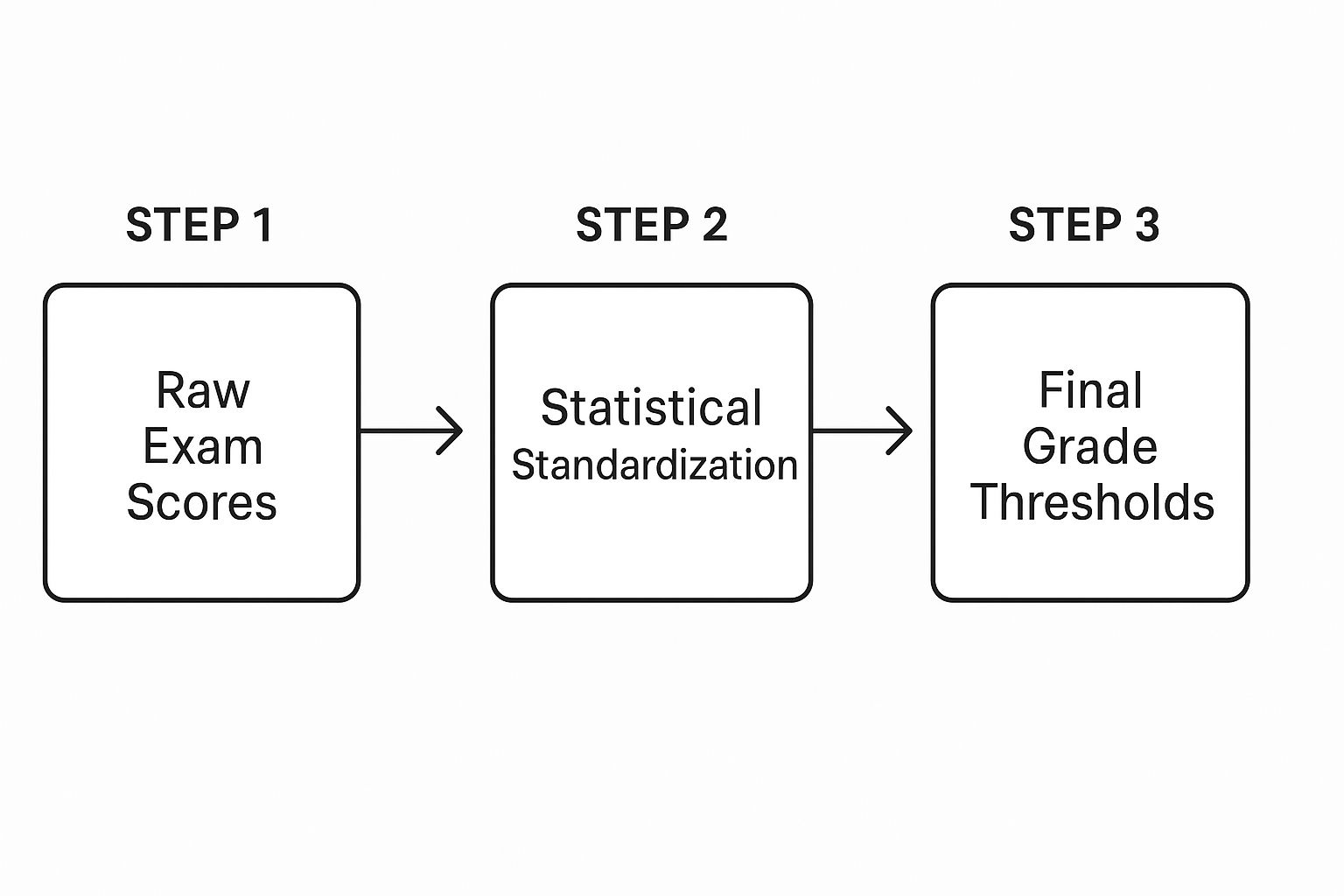A Level grade boundaries are the minimum marks a student needs to get a specific grade, like an A*, A, or B. These aren't set in stone; they actually change every year. This is done to make sure the system is fair, adjusting for how difficult that year's exam paper was, so that a grade A always represents the same level of achievement. It's a system designed to protect your child, ensuring their hard work is fairly recognised.
What Are A Level Grade Boundaries and Why Do They Matter
Results day is a whirlwind of emotions. For parents, seeing your child on the cusp of their next big step is a mix of immense pride, hope, and let's be honest, a little bit of anxiety. Amidst all this, the term "grade boundaries" can sound like a complicated and stressful piece of jargon, adding confusion to an already charged day.
But what if we looked at it differently? Instead of seeing it as a rigid target, think of A Level grade boundaries as a fairness mechanism, designed with your child’s best interests at heart. Their purpose is simple: to ensure a grade A in biology this year represents the same standard of work as a grade A last year, even if the exam papers were completely different. This protects your child from being unfairly penalised for something completely out of their control.

A Tool for Fairness, Not a Fixed Target
Imagine your child sat a particularly tough maths exam. They come out feeling deflated, convinced they’ve messed up a question everyone found difficult. Your heart sinks a little, hearing their worry after months of revision. If the pass mark was always a fixed number—say 70% for an A—your child and their classmates would be unfairly penalised just for having a harder paper.
This is where grade boundaries step in to level the playing field. In this scenario, the exam board would lower the mark needed for an A to compensate for the paper's difficulty. The system is built to protect students from the bad luck of sitting a 'bad' paper.
The core principle is that a student’s final grade should reflect their knowledge and ability, not the specific difficulty of the exam they happened to sit on a particular day.
This ensures fairness and consistency across years, subjects, and even different exam boards like AQA, Edexcel, and OCR. Understanding this can transform your perspective from one of anxiety to one of confidence in the system. It's a crucial concept, especially for students studying in different ways; as explained in our guide to distance learning A-Level courses, the grading standards remain consistent regardless of the learning environment.
Essentially, these boundaries help make sure that:
- Exams are fair: Your child isn't disadvantaged by an unusually difficult paper.
- Standards are consistent: An A grade has the same value year after year.
- Results are reliable: Universities and employers can trust the grades awarded.
Knowing this, you can feel reassured that the system is designed to give your child a fair assessment of all their hard work.
How Grade Boundaries Are Actually Decided
Ever wondered who gets the final say on the marks needed for an A or a B? It’s easy to picture some faceless algorithm making the call, but the reality is far more human—and a lot more thoughtful. The process is actually a careful blend of expert judgement and statistical analysis, all designed to make sure every student, including your child, gets a fair result.
Think of it like the judges at a national baking competition. Their job is to ensure that a prize-winning cake this year is just as brilliant as last year's winner, even if this year’s recipe was much trickier. They aren’t just ticking boxes; they’re using years of expertise to maintain a consistent standard of excellence.
In much the same way, senior examiners—who are highly experienced teachers and subject specialists—sit at the very heart of setting A-Level grade boundaries. Their role is absolutely crucial in making the system fair for your child.
The Human Touch Meets Statistical Data
The whole process kicks off after every single exam paper has been marked. The exam board gathers a team of its most senior examiners for a critical meeting known as the 'awarding'. During this session, they meticulously review a wide range of real, anonymised student scripts from that year’s exams.
They pay special attention to the scripts that are hovering on the borderline between grades. For instance, they’ll scrutinise papers that are just above and just below what might become the final boundary for a grade B. They're asking some really important questions, always thinking of the students behind the papers:
- Does this work show the typical understanding and skill we’d expect from a B-grade student?
- Is the quality of this work comparable to a B-grade script from last year?
- Does this script show a clear step up from what we’d expect from a C-grade student?
This hands-on review ensures that the final grade boundaries reflect a real, tangible standard of student achievement, not just a set of abstract numbers. It’s a human-centred approach designed to protect your child and their peers.
This visual shows the simplified journey from your child's raw exam score to their final grade.

As the infographic shows, the final thresholds are the result of a multi-stage process, blending raw performance with careful statistical moderation.
The Role of Ofqual and National Data
While the senior examiners provide that essential qualitative judgement, their decisions are backed up by a wealth of statistical evidence. This is where Ofqual, the exam regulator for England, plays a vital role, overseeing the entire process to ensure consistency and fairness across all exam boards.
The process is highly data-driven. Exam boards analyse various data points, including historical grade distributions and even students' Key Stage 2 results from primary school, to predict how a particular cohort is likely to perform. This insight is then combined with the hands-on feedback from senior examiners reviewing work at potential boundary marks. You can discover more insights about this comprehensive process on edumentors.co.uk.
Essentially, the statistics provide a starting point, but the final decision rests on the expert judgement of experienced educators. They find the 'tipping point' mark that best represents a C, B, or A standard of work.
This careful, multi-layered process should offer some real reassurance. Knowing that your child’s grade is determined by real experts—whose primary goal is to maintain fairness and recognise genuine achievement—can help ease the anxiety of results day. The system is built to ensure their final grade is a reliable and accurate reflection of their hard work and ability.
Why Do Grade Boundaries Change Every Year?

It’s one of the biggest sources of anxiety on results day: seeing the goalposts move. You might look at last year's A-Level grade boundaries, then see this year’s are different, and feel that familiar knot in your stomach. It’s completely natural to worry if the marks needed for a top grade are suddenly higher or lower than your child had planned for.
This feeling of uncertainty is something countless families experience every single year. But the important thing to remember is that this fluctuation isn't a flaw in the system—it's actually a sign that it's working to protect students and keep things fair. These changes happen for very specific reasons, all designed to ensure your child gets the grade they truly deserve.
The Two Key Factors Driving Change
When you peel back the layers, the movement in grade boundaries really comes down to two simple but powerful factors. Getting your head around these can help turn that feeling of anxiety into one of reassurance.
The system is built to balance:
- The difficulty of the exam paper: No two exam papers are ever identical in their level of challenge.
- The overall performance of the students: How the national group of students taking that specific exam performs as a whole.
Think of it like adjusting the difficulty on a video game. If a level is unexpectedly hard and very few players can get through, the game developers might patch it to make it more achievable. In the same way, if an exam paper turns out to be tougher than intended, the grade boundaries are adjusted downwards so students aren't unfairly penalised.
A Practical Example: A Tough Chemistry Paper
Let's imagine your child has just sat their A-Level Chemistry Paper 2. They come out of the exam hall looking pale, talking about question 6, a complex problem on organic synthesis that was much harder than anything in the practice papers. Your heart aches as you see their confidence drain away.
If the grade boundaries were fixed, that one tricky question could unfairly drag down the grades of thousands of hardworking students, including your own. But because the system is flexible, the exam board will spot this pattern when they analyse the results. Senior examiners will review the scripts, look at the data, and agree that the paper was more demanding than last year's.
To compensate, they will lower the grade boundaries. The raw mark needed to get an A might drop from, say, 75% last year to 71% this year. This adjustment makes sure your child's final grade reflects their genuine understanding of chemistry, not their bad luck in facing one particularly nasty question.
This isn’t about lowering standards. In fact, it’s the very definition of maintaining them. It ensures that an A grade represents the same high level of achievement, year after year, regardless of a particular paper’s difficulty. The system is designed to judge students on their knowledge and skill, creating a level playing field for everyone.
Comparing Boundaries Across Subjects and Exam Boards
It’s a classic results day conversation: you hear your child’s raw score in Maths and instinctively compare it to their friend’s score in History. It’s a completely natural reaction, but it’s a bit like comparing apples and oranges. Every A-Level subject is unique, testing different skills and knowledge, which means their A-Level grade boundaries will be different too.
Getting your head around this is vital. It helps you see your child’s results for what they are—a measure of their individual achievement in a specific field—rather than getting lost in unfair comparisons. It stops you from worrying needlessly and lets you celebrate their hard work with the right perspective.
Why Every Subject Is Different
The very structure of an A-Level has a massive impact on how its grade boundaries are set. Some subjects lean heavily on final exams, while others have a big chunk of coursework or a practical element. This fundamental difference means the raw marks needed for a top grade can vary wildly.
Let’s look at two practical examples:
- A-Level Physics: This is a classic exam-heavy subject. Your child's final grade hinges on their performance across a few high-stakes papers sat at the very end of two years of study. The pressure is immense.
- A-Level Art and Design: Here, a large coursework portfolio, built over many months, makes up a huge portion of the final mark. It's a test of sustained effort and creativity, not just memory recall under pressure.
A raw score of 78% in Physics might show an outstanding grasp of complex theories under intense exam pressure, easily earning a solid A. But that same 78% in Art, which includes months of portfolio development, might land in the B grade category. Neither grade is 'better' than the other; they just reflect different skills assessed in different ways.
The key takeaway is that a percentage score on its own doesn't tell the full story. The subject, the assessment structure, and the performance of the entire student cohort all play a crucial role in determining what that score is worth.
The Role of Exam Boards: AQA, Edexcel, and OCR
Adding another layer of complexity is the role of the different exam boards, like AQA, Edexcel, and OCR. While Ofqual ensures standards are comparable across all of them, each organisation designs its own unique exam papers. In any given year, one board's Maths paper might just be a little bit trickier than another's.
To keep things fair for your child, each board sets its own grade boundaries for its own qualifications. This is why a student sitting an Edexcel paper might need a slightly different raw score for an A than a student sitting an AQA paper for the exact same subject. The whole system is designed to balance out these subtle differences.
This variation is easy to spot in the official data. For example, in a past Edexcel exam series, the A* boundary for A-Level Economics A was set at 287 raw marks out of a possible 335 (that’s about 85.7%). But for A-Level History in the same exam session, an A* required 173 out of 200 marks (86.5%). These figures, which you can find on the exam board websites, show how both the total marks and the percentages needed for top grades shift from subject to subject. This careful calibration ensures a grade reflects a comparable level of achievement, no matter the subject or exam board.
To make this clearer, here’s a hypothetical look at how boundaries can differ.
Example A-Level Grade Boundary Comparison (Hypothetical)
This table shows how the raw marks needed for each grade can differ significantly between subjects, even within the same exam session.
| Grade | Subject A (e.g. Maths) Raw Marks (out of 300) | Subject B (e.g. Sociology) Raw Marks (out of 200) |
|---|---|---|
| A* | 255 (85%) | 168 (84%) |
| A | 225 (75%) | 150 (75%) |
| B | 195 (65%) | 132 (66%) |
| C | 165 (55%) | 114 (57%) |
| D | 135 (45%) | 96 (48%) |
As you can see, a score of 75% earns an A in both subjects, but the raw mark totals are completely different. This is why focusing on the final grade, not the raw score, is what truly matters.
Understanding these nuances is particularly helpful for students thinking about more flexible ways of learning. For those exploring different paths, our guide to distance learning A-Level courses can offer valuable insights into how qualifications work outside a traditional school setting. The standards and grading remain the same, but the approach to learning can be shaped to fit your child's needs.
Ultimately, focusing on your child’s personal progress within their chosen subjects is far more constructive than getting caught up comparing raw scores.
A Brief History of A Level Grading
To really get your head around the A-Level system your child is navigating, it helps to look back at how it’s grown and changed over the years. The A-Level grade boundaries we see today didn't just appear overnight; they’re the result of decades of fine-tuning, all with the goal of better reflecting what a student truly knows and can do. This journey reveals a system that’s thoughtful, resilient, and always adapting to the needs of new generations of young people.

A-Levels first came on the scene way back in 1951, taking over from the old Higher School Certificate. In those early days, grading was incredibly simple. It was basically a pass/fail setup, with an added 'distinction' for the very top students. This worked for a while, but it lacked the detail needed to tell the difference between the wide range of student abilities.
It soon became clear that a more nuanced approach was needed to do justice to each student's effort. By the mid-1960s, the familiar letter grades we know today—A, B, C, D, and E—were brought in. This was a huge step forward, giving universities and employers a much clearer picture of an applicant's academic performance.
From Letters to Stars
For many years, an A was the highest grade a student could possibly achieve. But as teaching improved and more and more bright students started hitting that top mark, another problem emerged: how to pick out the truly exceptional performers?
This led to the next big shift in A-Level grading.
- The Introduction of the A*: In 2010, the A* grade was officially added to the scale.
- Purpose of the A*: It was created to help the most competitive universities distinguish the very best candidates from a growing pool of high-achievers.
- Requirement for an A*: To get one, a student doesn’t just need an overall A. They also have to score exceptionally high marks (at least 90% on average) across their final year (A2) exams.
This wasn't about making A-Levels harder. It was about adding a new layer of recognition for outstanding academic talent.
Knowing this history can be quite reassuring. It shows the A-Level system isn’t set in stone. It’s a living framework that’s been carefully tweaked over 70 years to make sure your child’s final grades are a fair and accurate reflection of their hard work.
Adapting to Modern Challenges
The system's strength was truly put to the test during the COVID-19 pandemic. With exams cancelled in 2020 and 2021, the entire assessment model had to be rethought, switching to teacher-assessed grades. That period really hammered home the importance of a fair and trusted grading system. The recent return to pre-pandemic standards shows a solid commitment to protecting the long-term value and integrity of A-Levels.
This rich history, from simple pass/fail to the complex challenges of recent years, is well-documented. If you're curious about the nitty-gritty of the early grading structures and their evolution, you can find more details on Wikipedia.
While we reflect on this history, it's also interesting to look at how assessments are changing today. For instance, exploring the evolving landscape of assessment with digital portfolios shows how new methods are emerging to showcase a student's skills beyond traditional exams.
Your Questions About Grade Boundaries Answered
The run-up to results day can be a tense time, filled with a mix of excitement and anxiety. It’s a period where a thousand "what if" questions can swirl around, for both you and your child. This is completely normal. Often, the best way to feel calmer and more prepared is to understand exactly how the system works.
Here, we'll walk through some of the most common worries that families have about A-Level grade boundaries. Our goal is to give you clear, straightforward answers that put your child’s needs first, helping you feel ready to support them with confidence.
Can We Predict This Year's Grade Boundaries?
It’s one of the first things parents and students do—look up last year’s boundaries to try and figure out what might be needed this time. While it’s a natural instinct, trying to predict the exact marks needed for a grade is often a recipe for unnecessary stress for your child. The simple truth is, it’s impossible to know for sure until every single paper has been marked.
The final boundaries are only decided after a detailed review of all the exams. They depend entirely on two key things: the specific difficulty of the paper your child sat, and the overall performance of every student who took it that year across the country.
Instead of focusing on predictions, it's far healthier to help your child focus on what was within their control—all the hard work and revision they put in. Past boundaries are a rough guide at best; they should never be treated as a guarantee.
Remember, the system is designed to be flexible. This is what ensures a fair result for every single student, no matter if their exam was a bit easier or tougher than the year before.
What If My Child Is Just One Mark Off a Grade?
Seeing your child miss out on a higher grade by a single, heart-wrenching mark is incredibly tough. It can feel deeply unfair, and it's perfectly okay for both of you to feel disappointed. The most important thing to know is that this isn't necessarily the end of the road. You have options.
The first step is to speak with their school or college tutors immediately. They are your best allies and can guide you through requesting a 'review of marking' from the exam board, which is often called a remark. A senior examiner, who had nothing to do with the original marking, will then re-check the script for any mistakes.
However, it's vital to make an informed choice together. Here’s what you need to consider:
- Grades can go down as well as up: A review isn’t a one-way street. There is a real risk the mark could be lowered.
- The school can offer advice: Many schools will look over the script themselves first to judge the likelihood of a grade change.
- There are tight deadlines: The window for requesting a review is very short, often just a couple of weeks, so you must act quickly.
This process is all about ensuring accuracy. If a genuine error has been made, a review can put it right and give your child the grade they truly earned.
Do Lower Grade Boundaries Mean Students Were Less Able?
Absolutely not. This is one of the most persistent and damaging myths about A-Level grade boundaries, and it can cause a lot of needless worry for students who have worked so hard. Lower grade boundaries are almost always a sign that the exam paper itself was more challenging than in previous years.
Think of it as a fairness mechanism. If a marathon route is much hillier one year, the average finish times will naturally be slower. You wouldn't say the runners were less fit; you'd acknowledge the course was tougher. It's exactly the same principle with exams.
A drop in grade boundaries shows that the system has worked correctly. It has identified a more difficult paper and adjusted the scale to ensure that students like your child are not penalised.
This adjustment means your child's grade is a true reflection of their academic ability, not just a measure of how they coped with an unusually hard set of questions. It's a sign of a fair system protecting its students.
Where Do We Find the Official Grade Boundaries?
On A-Level results day, all the official grade boundary documents are published by the awarding bodies—the exam boards like AQA, Pearson Edexcel, and OCR. You can find these documents directly on their websites, usually from the morning of results day.
Your child’s school will also have access to all this information. The results slip they receive will show their raw mark for each paper or component. School staff can then help you match these raw marks to the official boundary tables, giving you a crystal-clear picture of their performance and how their final grade was decided.
Understanding how these grades translate into university entry requirements is the next crucial step. The grades themselves are used to calculate UCAS points, which many universities use in their offers. To feel fully prepared, you may want to read our guide on how to define UCAS points and support your child through their university application journey. This will help you connect the dots between their A-Level results and their future ambitions.
At Queens Online School, we believe in empowering families with the knowledge they need to navigate every stage of their child’s education. If you're looking for a supportive and flexible learning environment that prioritises your child's individual journey, explore how we can help at https://queensonlineschool.com/.

